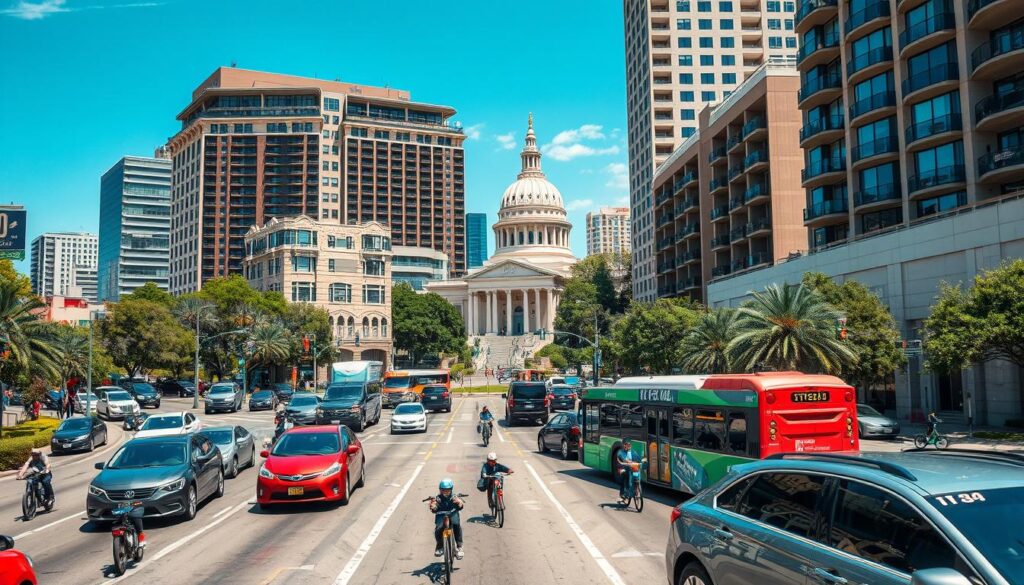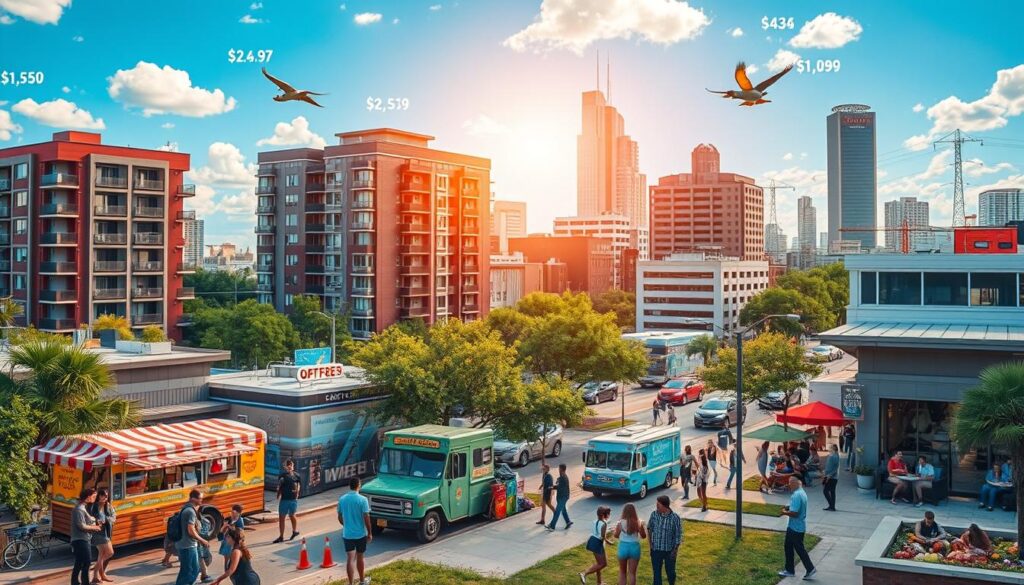How Much Money Do I Need to Move to Austin?
Get Your Free Moving Estimate
Relocating to a new city is a thrilling adventure, but it also comes with its own set of challenges, particularly regarding finances. The question, “How much money do I need to move to Austin?” is essential for anyone considering this move. Understanding the various costs involved in relocating to Austin financial planning is crucial to ensure a smooth transition. In this article, we aim to provide you with a comprehensive insight into the expenses you need to anticipate, from housing and transportation to daily living costs. Our commitment at HeavenlyMove is to equip you with the necessary knowledge to facilitate an enjoyable and hassle-free move.
Key Takeaways
- The total cost of moving to Austin varies based on individual circumstances.
- Key factors include housing, transportation, groceries, and healthcare.
- Savings and emergency funds are vital for a smooth transition.
- Understanding local costs helps in effective financial planning.
- Budgeting for entertainment and lifestyle is crucial when moving.
Overview of Moving Costs
When planning your move to Austin, understanding moving costs is crucial for a smooth transition. Moving expenses to Austin can vary widely based on several factors. We will explore these key elements and provide insights on how to estimate your budget for moving to Austin effectively.
Key Factors Affecting Costs
Several factors play a significant role in determining the overall cost of living in Austin. Here are the main considerations:
- Distance: Moves involving greater distances typically incur higher costs due to fuel and travel time.
- Size of the Move: Larger moves with more belongings can lead to increased labor and packing material expenses.
- Time of Year: Peak moving seasons, such as summer months, often result in higher rates due to demand.
- Services Required: Additional services such as packing, unpacking, and storage can substantially impact moving expenses to Austin.
Estimating Your Budget
When creating your budget for moving to Austin, consider both fixed and variable expenses. Fixed expenses might include truck rentals and professional moving fees, while variable costs could involve unforeseen expenses like extra packing material or last-minute changes. Here’s a detailed breakdown:
| Expense Type | Estimated Cost |
|---|---|
| Truck Rental | $200 – $800 |
| Professional Movers | $1,000 – $3,000 |
| Packing Supplies | $100 – $300 |
| Fuel Costs | $50 – $200 |
With a clear understanding of the cost of living in Austin and how various factors influence moving expenses to Austin, we can minimize surprise costs and better prepare for the move.
Housing Expenses in Austin
When estimating expenses for moving to Austin, housing costs represent a significant portion of your overall budget. Familiarizing yourself with average rent prices, home buying costs, and utilities will help you navigate the cost of living in Austin effectively.
Average Rent Prices
The rental market in Austin has seen various fluctuations. In general, understanding average rent prices can guide your search for a suitable home. Here is a breakdown of typical rent prices by neighborhood:
| Neighborhood | 1 Bedroom (Monthly) | 2 Bedroom (Monthly) |
|---|---|---|
| Downtown | $2,200 | $3,000 |
| South Congress | $1,950 | $2,700 |
| East Austin | $1,800 | $2,400 |
| North Austin | $1,600 | $2,100 |
Home Buying Costs
Buying a home in Austin involves several initial costs beyond just the purchase price. Key expenses include:
- Down Payment: Typically ranges from 3% to 20% of the home price.
- Closing Costs: Usually about 2% to 5% of the loan amount.
- Property Taxes: Can vary significantly, averaging around 2.2% of the property’s assessed value.
Utilities and Service Fees
Utilities are an ongoing expense in any household. In Austin, residents should budget for the following services:
- Electricity and Heating
- Water and Sewage
- Internet and Cable
The average monthly utility bill for an apartment can reach around $150. Adjusting your budget to accommodate these necessary costs is vital when estimating expenses for moving to Austin.
Transportation Costs in Austin
Understanding transportation costs is essential when considering the cost of living in Austin. We can break down these expenses into several categories, including public transportation options, car ownership expenses, and ride-sharing services. Planning your transportation needs early becomes critical for accurate budget estimation, especially regarding your moving expenses to Austin.
Public Transportation Options
Austin features a public transportation system managed by Capital Metro. This service includes buses and a light rail line, which can significantly reduce commuting costs. The following are popular options:
- Monthly passes range from $60 for adults to $30 for students.
- Single ride fares are typically around $1.25.
- Access to an extensive network of bus routes reduces the need for personal vehicles.
Car Ownership Expenses
If owning a car is necessary, potential costs should be evaluated. Car ownership can bring about a variety of expenses, such as:
- Insurance: Average monthly premiums may range from $100 to $200.
- Maintenance: Regular servicing can cost around $500 annually.
- Fuel: Monthly fuel expenses generally average between $100 and $150.
Ride-Sharing and Taxi Services
For flexibility and convenience, ride-sharing services like Uber and Lyft present competitive alternatives. The typical costs for these services can vary based on demand but are generally manageable:
- Base fare often starts at approximately $2.
- Additional fees may include $0.15 per minute and $0.95 per mile.
- Taxi services can also be found, with standard urban rates around $3.00 for the initial fare and about $2.00 per mile.

Groceries and Daily Living Costs
Preparing for the cost of living in Austin involves understanding the essentials required for daily life. Analyzing grocery prices, dining out, and other necessary expenditures helps in estimating expenses for moving to Austin more accurately. We will outline average grocery prices, eating out costs, and expenses for other daily essentials to give a comprehensive view of what to expect.
Average Grocery Prices
Grocery prices can vary based on location and store type. However, here is a snapshot of average prices for common items found in Austin:
| Item | Average Price |
|---|---|
| Milk (1 gallon) | $3.50 |
| Bread (1 loaf) | $2.50 |
| Eggs (1 dozen) | $2.00 |
| Chicken (1 lb) | $4.00 |
| Fresh produce (per lb) | $1.50 |
Eating Out in Austin
The culinary scene in Austin offers a variety of dining options to suit various budgets. Here is a breakdown of average meal costs at different establishments:
| Type of Meal | Average Cost |
|---|---|
| Fast food | $8.00 |
| Casual dining | $15.00 |
| Fine dining | $30.00 |
Cost of Other Essentials
Other daily essentials, such as personal care and household items, contribute significantly to the overall cost of living in Austin. Here’s a look at some common expenses:
- Toilet Paper (12 rolls) – $7.00
- Shampoo (16 oz) – $5.00
- Dish Soap (24 oz) – $3.00
- Pet Food (30 lb) – $20.00
Healthcare and Insurance Costs
Healthcare costs play a pivotal role in our financial planning as we embark on relocating to Austin. Understanding the available health insurance options and average medical expenses will help you make informed decisions. We will also explore local healthcare providers to ensure a comprehensive healthcare network upon your move.
Health Insurance Options
Choosing the right health insurance is essential for managing healthcare expenses. In Austin, several options exist:
- Employer-sponsored plans: Many employers provide health insurance, often covering a portion of the premium.
- Individual policies: If self-employed or working for a company without health benefits, individual policies are available through the marketplace.
- Medicaid and Medicare: For those who qualify, these government programs can help alleviate healthcare costs.
Average Medical Expenses
Medical expenses can vary, but having an idea of the common costs you may incur is crucial. The following table outlines typical expenses you might expect in Austin:
| Medical Service | Average Cost |
|---|---|
| Doctor Visit | $150 |
| Dental Cleaning | $100 |
| Prescription Medication | $25 |
| Specialist Visit | $250 |
Local Healthcare Providers
Knowing where to seek care will enhance your experience in Austin. Notable healthcare providers include:
- Seton Healthcare Family: Offers a range of services, including hospitals and outpatient care.
- St. David’s HealthCare: Known for excellent emergency care and specialty services.
- Texas Children’s Hospital: Provides comprehensive pediatric care and support.
Entertainment and Lifestyle Expenses
Austin’s vibrant lifestyle offers numerous entertainment options that cater to diverse tastes. Understanding the associated costs plays a vital role when considering the cost of living in Austin. From dining to outdoor adventures, we’ll break down average entertainment expenses, outdoor activities, and cultural attractions that enhance life in this lively city.
Average Entertainment Costs
Engaging in recreational activities often involves certain financial commitments. Here are some typical costs one might encounter:
- Movie tickets: $11 – $15
- Concert tickets: $20 – $150, depending on the artist and venue
- Membership fees for local venues: $50 – $300 annually
Outdoor and Recreational Activities
Austin’s natural beauty encourages a range of outdoor activities, but some may involve fees:
- Park entrance fees: free – $10 (for specific parks)
- Biking trails and rentals: $10 – $30 per day
- Water sports rentals (kayaks, paddleboards): $15 – $50 per session
Cultural Attractions in Austin
The cultural scene in Austin is rich, with numerous attractions to explore. Here’s a glimpse of the typical entry fees:
| Attraction | Average Admission Fee |
|---|---|
| Blanton Museum of Art | $12 |
| Texas State History Museum | $13 |
| Austin Zoo | $12 |

Education Costs for Families
For families making the move to Austin, education plays an essential role in the budget for moving to Austin. Understanding the associated costs with both public and private schooling, as well as higher education expenses, can help families allocate their finances effectively. We will explore various educational costs, ensuring families are well-prepared.
Public vs. Private School Expenses
When deciding between public and private schools, it is crucial to consider the following expenses:
- Tuition: Private schools typically charge tuition, ranging from $5,000 to $30,000 per year.
- Supplies and Fees: Expect additional costs for school supplies, uniforms, and extracurricular activities.
- Transportation: Consider if transportation is included for private schools or if families must arrange their own.
College Tuition Prices
Families with older children should factor in college tuition when planning their budget for moving to Austin. In-state tuition for the University of Texas at Austin hovers around $11,000 annually, while out-of-state students can expect to pay around $40,000. Here is an overview of college tuition estimates for Austin-area institutions:
| College/University | In-State Tuition | Out-of-State Tuition |
|---|---|---|
| University of Texas at Austin | $11,000 | $40,000 |
| Texas State University | $10,000 | $26,000 |
| St. Edward’s University | N/A | $40,000 |
Childcare Costs
For families with younger children, childcare options are a vital aspect of the budget for moving to Austin. Average daycare costs range from $700 to $1,500 monthly, depending on the child’s age and the facility’s location. Factors to consider include:
- Type of Care: Full-time daycare, part-time options, and in-home care each have different price ranges.
- Quality and Accreditation: Higher-quality facilities often charge more but may provide better educational programs.
- Location: Prices can vary based on proximity to downtown or more suburban areas.
Savings and Emergency Funds
Planning for a successful move requires more than just estimating expenses for moving to Austin. It’s crucial to set aside adequate savings and establish an emergency fund to navigate unforeseen costs. Before relocating, we recommend targeting a specific savings amount based on your anticipated moving expenses and lifestyle adjustments in your new city.
Recommended Savings Before Moving
As a general guideline, aim to save at least three to six months’ worth of living expenses. This figure helps ensure you can comfortably transition into your new environment without financial strain. Below are some essential costs to consider when estimating your savings:
| Expense Category | Estimated Amount |
|---|---|
| Rent or Mortgage | $1,500 – $2,000 |
| Utilities | $150 – $300 |
| Groceries | $300 – $600 |
| Transportation | $200 – $400 |
| Healthcare | $200 – $500 |
| Miscellaneous | $100 – $300 |
Building an Emergency Fund
An emergency fund serves as a financial safety net after your move. We suggest saving at least $1,000 to cover immediate, unexpected expenses that might arise during your transition to Austin, such as car repairs or medical emergencies. This fund helps alleviate stress by providing peace of mind, knowing that unforeseen challenges can be managed with ease.
Financial Planning Tips
- Set a clear budget for your moving expenses to Austin, factoring in all related costs.
- Track your monthly expenses to identify areas where you can save.
- Consider alternative sources of income, like part-time work or freelancing, to boost your savings.
- Review your financial plan regularly to adjust your savings goals as needed.
Conclusion and Final Tips
As we wrap up our exploration of relocating to Austin financial planning, it’s essential to recap the key expenses you’ll encounter. From housing costs—whether renting or buying—to transportation, groceries, healthcare, and entertainment, understanding these facets provides a clearer picture of what to expect. Even the cost of education and childcare can significantly impact your budget. Tailoring your financial plan based on these key expenses will ensure you’re prepared for what lies ahead.
It’s important to approach budgeting for Austin with a tailored strategy that reflects your circumstances. Consider each factor we’ve discussed, from emergency funds to everyday living costs. By doing so, you can create a more robust financial plan that cushions you against unexpected expenses. Remember, thorough financial planning is not just about gathering funds but strategically placing them where they are needed most.
At HeavenlyMove, we are dedicated to making your move as smooth as possible. Our expertise in the Austin area equips us to assist you every step of the way during your transition. With the right preparations in place, your experience of relocating to Austin can be seamless, letting you focus on settling into your new home rather than worrying about financial uncertainties.
FAQ
How much money do I need to move to Austin?
The cost to move to Austin varies significantly based on factors such as the size of your household, the distance of the move, and additional expenses like moving supplies. On average, budgeting between ,000 to ,000 should cover most scenarios for a local to mid-range move.
What is the cost of living in Austin?
The cost of living in Austin is generally higher than the national average. Housing remains the most significant expense, with average rent prices ranging from
FAQ
How much money do I need to move to Austin?
The cost to move to Austin varies significantly based on factors such as the size of your household, the distance of the move, and additional expenses like moving supplies. On average, budgeting between $3,000 to $10,000 should cover most scenarios for a local to mid-range move.
What is the cost of living in Austin?
The cost of living in Austin is generally higher than the national average. Housing remains the most significant expense, with average rent prices ranging from $1,500 to over $2,500 for a one-bedroom apartment in the city center, while groceries and healthcare are also important factors to consider in your budgeting.
What are the moving expenses to Austin I should consider?
Key moving expenses to consider include hiring a moving company, transportation costs, packing supplies, temporary housing, and utility setup fees. It’s essential to account for both fixed and variable costs while planning your budget for moving to Austin.
How can I accurately estimate my budget for moving to Austin?
To estimate your budget, start with a detailed list of all potential costs, including moving services, housing, transportation, groceries, and any additional personal expenses. Research average costs in Austin and keep track of your projected expenses to ensure you’re prepared for the financial demands of relocating.
What type of financial planning is needed when relocating to Austin?
Relocating to Austin requires comprehensive financial planning. It’s crucial to evaluate your savings, understand your expected living expenses, and establish an emergency fund for unforeseen costs during or after your move. Consulting with a financial advisor may help in creating a realistic and effective budget plan.
How does transportation cost affect my total moving expenses to Austin?
Transportation costs can significantly influence your overall moving budget. Consider whether you will use public transportation, own a vehicle, or utilize ride-sharing services, as each option carries different expenses. Assessing your transportation needs early in the planning phase can help you make cost-effective decisions.
What are some tips for estimating expenses for moving to Austin?
When estimating expenses, be sure to:\n
- \n
- Research housing markets for accurate rent or home buying costs.
- Calculate transportation costs based on your commuting needs.
- Include groceries and everyday expenses to gauge your monthly living costs.
- Set aside a budget for leisure activities and unexpected costs.
\n
\n
\n
\n
,500 to over ,500 for a one-bedroom apartment in the city center, while groceries and healthcare are also important factors to consider in your budgeting.
What are the moving expenses to Austin I should consider?
Key moving expenses to consider include hiring a moving company, transportation costs, packing supplies, temporary housing, and utility setup fees. It’s essential to account for both fixed and variable costs while planning your budget for moving to Austin.
How can I accurately estimate my budget for moving to Austin?
To estimate your budget, start with a detailed list of all potential costs, including moving services, housing, transportation, groceries, and any additional personal expenses. Research average costs in Austin and keep track of your projected expenses to ensure you’re prepared for the financial demands of relocating.
What type of financial planning is needed when relocating to Austin?
Relocating to Austin requires comprehensive financial planning. It’s crucial to evaluate your savings, understand your expected living expenses, and establish an emergency fund for unforeseen costs during or after your move. Consulting with a financial advisor may help in creating a realistic and effective budget plan.
How does transportation cost affect my total moving expenses to Austin?
Transportation costs can significantly influence your overall moving budget. Consider whether you will use public transportation, own a vehicle, or utilize ride-sharing services, as each option carries different expenses. Assessing your transportation needs early in the planning phase can help you make cost-effective decisions.
What are some tips for estimating expenses for moving to Austin?
When estimating expenses, be sure to:\n
- \n
- Research housing markets for accurate rent or home buying costs.
- Calculate transportation costs based on your commuting needs.
- Include groceries and everyday expenses to gauge your monthly living costs.
- Set aside a budget for leisure activities and unexpected costs.
\n
\n
\n
\n


